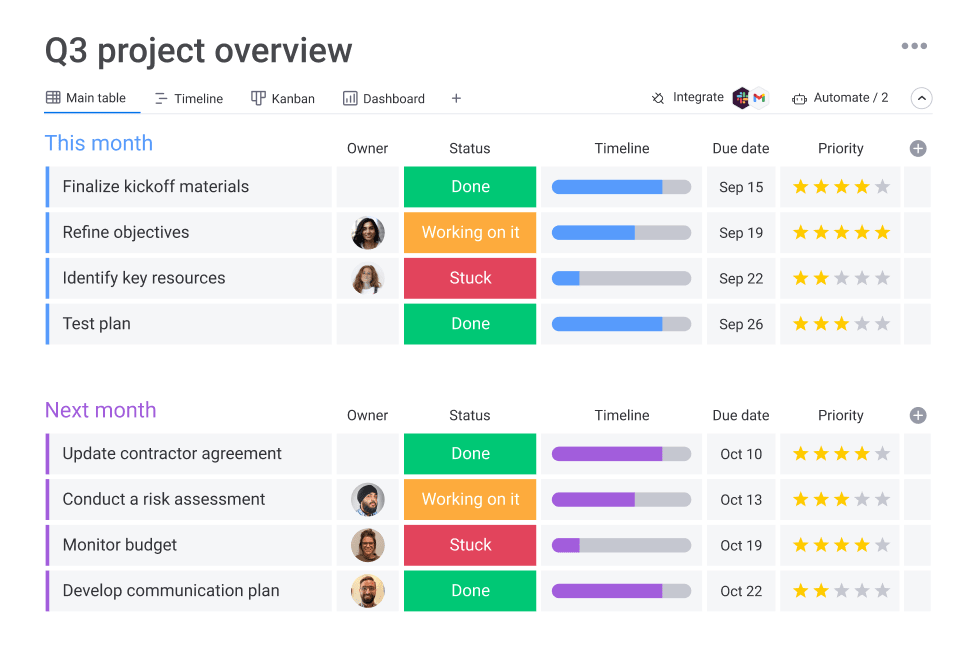Communication plays an essential role in the success of a business.
The efficiency of your company’s external communications paves the way to building your brand and selling your products and services. Additionally, your business’ internal communications enforce the connections between leaders, teams, and employees so that the business can effectively run without problems.
Today, it is easier to run an organization with a business communication app at your fingertips. Before we go over what a business communication app is and discuss some of its examples, let’s dive deep into the basics of business communication.
What Is Business Communication?
Business communication refers to the goal-oriented exchange of information between and among members of a business organization. It occurs internally and externally and defines whether a business has a solid foundation for effective information sharing.
The Two Main Categories of Business Communication
As previously mentioned, there are two main categories of business communication: internal and external.
The primary objective of external communications is to reach out to a target audience. Reaching out to customers makes them aware of your products or services and gives them a reason to purchase.
External business communications involve company branding, advertising, and direct correspondence via physical mail, email, and phone calls.
The two most important things for external communications are company image and consistency.
On the other hand, internal business communications facilitate the growth of a business from within an organization of team members and leaders. Its primary objective is to attract and retain skilled and hardworking employees while monitoring overall business performance.
As such, consistency in the relay of business goals is of the utmost importance. It provides direction to all company members and ensures that all those concerned work towards the same objective.
What Are the Characteristics of Effective Business Communication?
With effective communication, managers and employees correlate and interact efficiently to accomplish company goals and align with company core values.
It is the engine that improves organizational practices, eliminates information silos, and keeps all members informed to reduce and prevent business errors.
Without effective business communications, an organization cannot grow, much less become successful. Here is a list explaining what effective business communication should be:
1. Clear
All forms of business communication must be clear. They should contain a well-informed message, a method of conveyance, and a medium of transfer.
The message is what you, as the source, want to say, while the method refers to the manner of sharing or distributing the message.
On the other hand, the medium refers to the formats or channels through which you want to deliver the message. Without these three factors, clarity would be a problem for real-time communication.
2. Concise
In any business organization, all communications should be easily understandable. It is always better to use short sentences that are direct to the point.
3. Objective
Having a purpose is also necessary for business communication, and each particular purpose should be apparent to a target audience. Brainstorming an endgame helps you stick to your business goals while improving the effectiveness of your message.
4. Consistent
All business communications must carry consistent content and identity. Each message must have the same voice and tone so that readers at the receiving end won’t ever feel alienated.
Nevertheless, you can spice it up a bit with a change in tone now and then to lighten the mood.
5. Complete
Never leave your readers wondering and scratching their heads because of incomplete messages. Formulate complete and self-sufficient messages that have a logical conclusion.
6. Relevant
Avoid confusing your readers. Every part of business communications should be contextually cohesive with previous or future planned messages in the series.
Each new correspondence must be relevant to a previously released message. It should lead to future communications that will ultimately help you accomplish your goals.

What Are Business Communication Apps?
Now that you understand communications for business, we can discuss what business communication apps are.
When we say business communication apps, we mean computer-based technology and software tools that can simplify and modernize internal and external business communications.
At the very least, these tools include word processing apps, virtual spreadsheets, and presentation software.
Business communications have become simpler with email, messaging apps, team management apps, video conferencing tools, collaborative dashboards, file-sharing apps, and financial and accounting software.
Categories of Business Communication Software
We can also categorize business communication apps into two groups: synchronous and asynchronous.
Synchronous communication apps enable business communications in real-time and for all intended recipients. They include apps that allow instant messages, phone calls, video chats, and web conferences.
On the other hand, asynchronous communications software takes advantage of preset time delays to precisely deliver messages at a chosen time. Conversely, apps that require some time to complete a task for successful information exchange are also asynchronous communication tools.
The Importance of Business Communication Apps
Business communication tools have been around for some time now, and they have proven to be effective for many businesses.
Over the years, we have noticed the importance of such tools, and multi-billion dollar companies will attest to the fact. This section shall list all the benefits businesses can get from using business communications software.
- Improves employee engagement
- Reduces and eliminates data overloading
- Reduces and eliminates information silos
- Improves employee productivity
- Augments interdepartmental interactions
- Modernizes information sharing
- Enhances connectivity with remote workers
- Nurtures advocacy among employees
- Prevents company departure of employees
Best Business Communication Apps
1. Microsoft Teams
Microsoft Teams is a unified, all-in-one project management system that features enterprise-grade cloud communications. Its features include workplace chat, one-on-one video calls, video conferencing, meeting recordings, screen sharing, file sharing, file storage, and built-in integrations.
If your business already uses Office 365, Microsoft Teams is an easy pick. Both applications work together to enable highly productive business setups.
Microsoft Teams is available in a free plan with basic features for up to 300 users. However, meeting recordings are only available on the Business Essentials plan, which entails a $5 cost per user.
2. Slack
Slack has become the go-to business communication app for many companies. It has a built-in chat software that allows direct chat and team chat solutions with channel organization.
While this employee communication app does not offer video calls, it offers real-time communication through instant messaging. Furthermore, it has file sharing and collaboration tools.
Team members can join or leave messaging channels in Slack based on priority. With this feature, users can avoid receiving irrelevant messages and easily reference old messages.
Like Microsoft Teams, Slack is free to use but with limited features. The complete package requires a monthly subscription.
3. Cisco Jabber
Cisco Jabber empowers employees with efficient collaboration tools making it one of the best team communication apps. It features instant messaging, audio, video, and web conferencing, visual voicemail, and enterprise voice communication solutions.
In addition, it offers file sharing, scheduling, and recording. However, Cisco Jabber is more expensive than much other modern business communication software.
4. Webex App
The Webex App is another popular team communication app for businesses where workers need seamless communication channels across devices, organizations, and locations. It is an all-in-one communication platform that allows external and internal communication.
This application allows users to share files, make video phone calls, send messages, and attend meetings.
5. Monday.com
At Monday.com, users can design their own tools to run every aspect of their work for effective workplace communication. It is a unique communication app for business use that allows organizations to customize whatever they need to run their tasks efficiently.
It features to-do lists, team communication tools, task prioritization, day task management, and planning tools. Such tools enable business productivity by enforcing digital workplace collaboration.
6. Google Workspace
Google Workspace is also an all-in-one business communication tool offering enterprise-class security and seamless interchanges with Google Drive.
It has millions of active users from thousands of companies around the globe, and they can attest that it is an effective business communication app.
This cloud-based team communication app ensures that businesses can do all their tasks in one place. Aside from Google Drive, Google Workspace’s additional features include Gmail, Calendar, and several other content collaboration tools.
7. Zoho Cliq
Compared to other team communication apps, Zoho Cliq is one of the few that allows unlimited users under a free plan. It is the best option for businesses on a budget.
Flexible communication features include file sharing, audio and video conferencing, conversation threads, and virtual meetings. Of course, this app also offers storage for file sharing.
Zoho Cliq is one of the few team communication apps that efficiently help an entire team in organizing conversations. Furthermore, it features easy operation even on mobile devices.
8. Basecamp

Basecamp is the go-to business communication app for web-based organizations. It is an app trusted by millions of users, and it features to-do lists, digital file organizers, scheduling, milestone tracking, and many more.
Basecamp can easily loop in clients and target audiences, unlike many team communication tools.
9. Mattermost
If your company needs modern business communication software, you might want to check out Mattermost. Its built-in communication tools run directly on your servers, not on any third-party storage database.
This dedicated project management platform is open source, and its built-in integrations are highly customizable.
10. Flock
Flock boosts organizational productivity by speeding up and simplifying enterprise collaboration. It features built-in productivity apps, video conferencing, team member tagging, business chat, and guest invitations.
This app integrates popular business tools, and it has an easy-to-use interface. While it is free to use for teams of up to 20 users, it also offers a paid plan with better features.
Other Effective Workplace Communication Tools
If the previously mentioned applications do not suit your needs, you might want to choose your employee communication app from the following:
- Bitrix24
- Twist
- Chanty
- ProofHub
- Connecteam
- Wrike
- Flowdock
- Sameroom
- Titan
- DialMyCalls
Which Is the Best Business Communication App?
We recommend the Microsoft Teams software bundle as the business communication app for all types of organizations. It has easy-to-understand features and offers packages that enable business startups to save on costs.
Another communication app for business that deserves credit is Slack. Next to Microsoft Teams, Slack has high rankings on the leaderboard for business communications. However, it does not have built-in video conferencing features.
Business Communication App FAQs
1. What are the different types of business communication?
As previously mentioned, business communication can either be external or internal. However, we can further categorize internal communications into upward, downward, and lateral categories.
Upward communications begin with lower-level team members and end with managers or team leaders. Alternatively, downward communications come from those with positions and trickle down to subordinates.
Finally, lateral communications take a web-like pattern, occurring among all employees within an organization.
2. What are the main objectives of business communication?
The main objectives of business collaboration and communication include the following:
- information exchange;
- plan development;
- plan implementation;
- policy formulation;
- organizational goal achievement;
- resource organization;
- coordination;
- direction; and,
- employee motivation.
3. What are the features of communication software?
When choosing a business app, each of the following features is an essential component for company communications:
- direct messaging;
- group messaging;
- video chat;
- screen-sharing;
- audio conferencing;
- secure file-sharing;
- third-party app integrations;
- note-taking;
- mailing lists;
- company directories; and,
- information databases.
4. What is the most common form of business communication?
The most common form of business communication is emailing.
With its ease of use, business emails have overwhelmingly transformed communications at the professional level. It is the mode of communication most preferred by many.
The advantages of emails include remote messaging, file sharing, and direct and group messaging.
Nevertheless, it would be best to supplement emails with timely incorporations of audio-conferencing, video chats, and other business communication tools.
5. What are the disadvantages of communication technology?
Some of the advantages of business communication apps can also act as deterrents. For this reason, it is important to choose the right communication tools carefully.
Here are some disadvantages:
- overwhelming loads of information;
- integration of work hours into personal time;
- increasing use of the wrong medium for communication;
- poor cyber security implementations; and,
- personal use of work-related tools.














